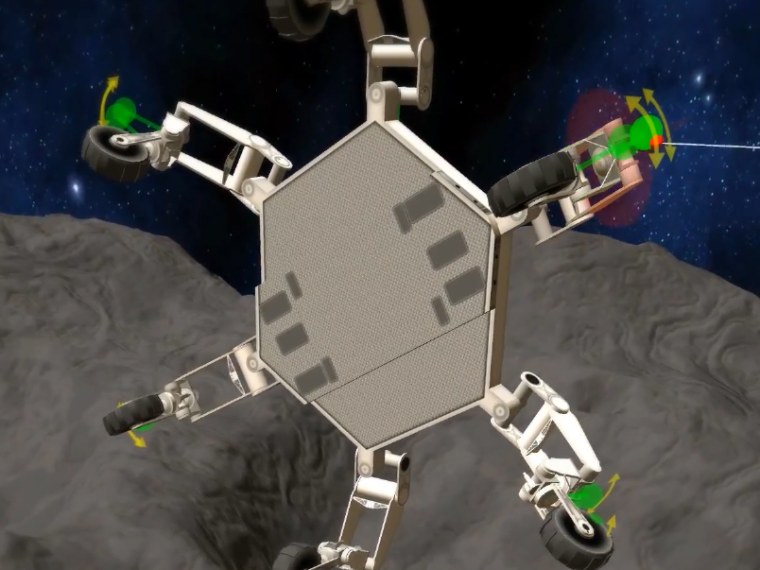
“You are the space invaders,” NASA manager Jeff Norris declared last week to a packed audience at the Game Developers Conference (GDC) in San Francisco.
It was a dramatic ending to a surprise talk scheduled at the last minute into a conference usually packed with the most arcane and theoretical pieces of trade information game developers swap with one another over a week at San Francisco’s Moscone Convention Center. Gamers and developers alike may have been confused to see real-world space exploration suddenly creep into a flurry of conversations about virtual worlds, but, as Norris explained during his presentation, NASA’s projects have often overlapped with the work of game designers.
To start, there’s the “hallowed ground of the living room,” where viewers first witnessed the legendary Apollo 11 landing, which Norris said was the most watched television broadcast at the time in history.”
The living room is “a place we'd like to be again,” Norris said.
While the aerospace organization may still be working on its giant leap into people’s consoles, NASA has already made its way back to the living room with a series of small steps. Last June, NASA released the Kinect-based game “Mars Rover Landing” in collaboration with Microsoft’s Xbox 360 team to give players a chance to control the Curiosity rover during its precipitous landing on the surface of the red planet—which was, uncharacteristically for video games, not peopled with tons of scary Martians, demons, and gateways to hell for once (Sorry, id.)
Norris acknowledged the “Mars Rover Landing” game along with a small handful of other interactive initiatives that NASA has attempted in the past. But for the future of space exploration, NASA is thinking bigger than a standalone Kinect game. Indeed, Norris and his colleague Victor Luo, a NASA human interface engineer, said that NASA is now working with game controller developers like Microsoft and Leap Motion to come up with new ways to control robots of all shapes and sizes.
Norris and Luo showed GDC a few early prototypes for this new technology, remotely controlling a massive six-limbed spider-like robot referred to as ATHLETE (All-Terrain Hex-Limbed Extra-Terrestrial Explorer, “we have a weird fetish for acronyms,” they joked) with the palm of one of Luo’s hands as footage was live-streamed to the conference through a Google Hangout.
The two admitted that the current examples were more simulations than video games per se, calling them “part game, part not game.” But Luo joked that the thought of “moving a one-ton robot with my hand” was probably “every gamer geek space fan boy’s dream.” This quasi-gameplay was “the cool stuff, the hardcore gameplay, the stuff that made us NASA”—and, therefore, the stuff that NASA was hoping would reignite our curiosity for government-funded space exploration.
But Norris and Luo didn’t stop there. Instead, they laid out a bold and science fiction-drenched vision for the future of NASA and space exploration more generally.
"We all desperately want ‘Star Trek,’" said Norris. "I do believe that humanity's destiny is to climb aboard starships and explore the universe. I think at last we finally have in our grasp the technology necessary to build a very important room on this vessel."
"I am overwhelmed with hope, but also impatience," Norris continued as M83 began to swell in the background. "I want us to build a future of shared immersive tele-exploration—everyone exploring the universe through robotic avatars, not just peering at numbers or pictures on a screen, but stepping inside a holodeck and standing on those distant worlds."
Having access to a real holodeck will probably take a few more years. Norris admitted to InGame in an interview after his GDC presentation that the holodeck itself is “shorthand,” saying that early versions of the new technology will probably be sophisticated renderings delivered to people through some kind of virtual reality device.
“Human beings are more simple than that,” Norris said when asked how people would feel being transported to the far reaches of space. “We need to accept the reality of the representation.” Yet he acknowledged that certain parts of space exploration would be harder to transmit virtually.
“The tactile sense is going to be challenging,” he said.
It’s tempting to see the NASA’s new video game-inspired tools as the storied aerospace organization bowing to newfound pressure from private companies. With everyone from Red Bull to NanoSatisfi trying to offer “affordable access to space” for the average consumer, after all, what place does public funding have for the future of space exploration? But Norris and Luo insisted that their goals are not necessarily competitive.
“As long as we’ve been exploring, there have been both kinds of exploration,” Luo told InGame. NASA, they reasoned, still has a unique ability to focus on research that isn’t immediately profitable.
“I wouldn’t call it pressure,” Norris said. “It’s really exciting!
“If that were the only way,” he added, referring to private space exploration, “there might be some scientifically valuable research lost. But it’s not.”
Yannick LeJacq is a contributing writer for NBC News who has also covered games for Kill Screen, The Wall Street Journal and The Atlantic. You can follow him on Twitter at @YannickLeJacq and reach him by email at ylejacq@gmail.com.